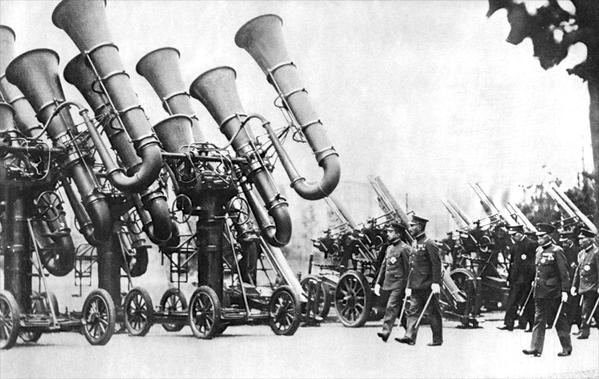Before radar was invented, the military had to rely on other, more primitive methods of detecting the enemy and monitoring its own forces.
In World War One, both sides had begun using aircraft, but the Germans had also used Zeppelins to bomb enemy targets, But it was in World War Two that warfare in the skies really took hold. Bombing raids using aircraft were vital features of both the Allied and the German military strategies.
If incoming aircraft were detected, fighter planes would be launched to counter the attack by heading off the enemy or shooting them down.
Without radar, listening devices were crucial. Aircraft engines could be heard miles off, so listening devices were at the center of military research and development. Some devices were produced small and mobile, so that a person could carry them. Anyone on the move could listen and tune in to potentially approaching aircraft through headphones.
However, the further away that aircraft could be detected, the better the reaction and response, so bigger, more complex devices were also produced. Many were just experiments and their abilities were wide-ranging.
In the 1920s, huge amplifiers were being used by the US Naval Air Service. They could find and contact aircraft in the day or night.
By the 1930s, the Japanese had developed acoustic locators. They were mounted on a four-wheeled carriage. They were used throughout World War Two; but as aircraft technology developed, planes were travelling at vastly higher speeds by the end of the war and radar was becoming more widely used, so the Japanese ‘war tuba’ become obsolete.
Radar was originally developed in England in the mid-1930s.
Radar, or radio detection, was developed independently in quite a few different countries throughout the 1930s.
By the time World War Two was declared in 1939, both Britain and Germany had basic radar systems that worked. As the air war ramped up and Britain was under constant bombing through the Blitz, the Royal Air Force was using its radar system as a central part of its defensive strategy.
The Germans, meanwhile, had neglected their development of radar, since Hitler was more focused on offensive attacks than defensive measures. The Luftwaffe also failed to incorporate its version of radar into its air force, the Mashable reports.
The US continued to develop and test ship and land radar systems. The US Navy was the first US military arm to integrate it in 1940, and then the US Army, a year later.
At the start, all radar systems operated at a low frequency. In 1940, Britain developed the capability to produce more powerful systems, which opened up the next generation of radar. Britain and the US then worked together to develop and produce microwave radar.
Radar was also developed and used by the Soviet Union, Japan, Australia, New Zealand, Canada and South Africa.
